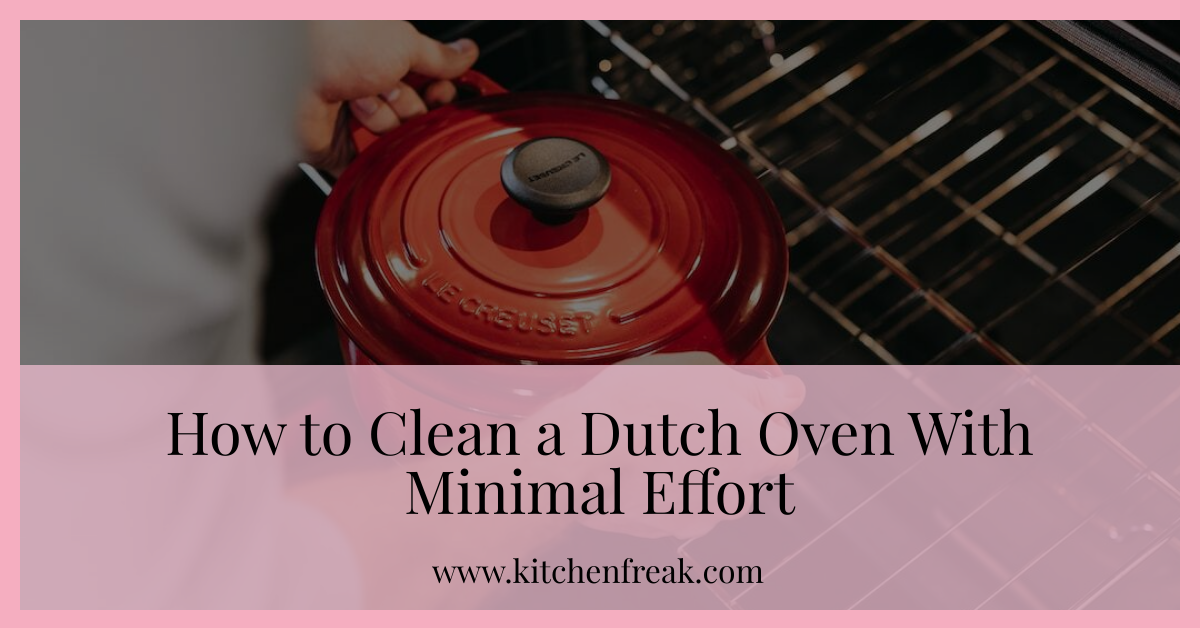Hello, and welcome back to my blog. Getting a kitchen appliance is easy, but maintaining it and keeping it clean needs effort and patience. You need to deep clean all your kitchen appliances occasionally to keep them in good condition. In this post, I will share in detail that how you can deep clean your Dutch oven in detail.

Table of Contents
Learn how to clean a Dutch oven
A Dutch oven is an expensive but heavy-duty kitchenware that caters to all your cooking and baking needs. Once you start using it to create yummy dinner recipes for your family, there is no going back. If you regularly deep clean it, it will last you long without noticeable wear and tear. The tip is to clean it after every wash so that the cooked food stains don’t get time to become stubborn. If, by any chance, your Dutch oven has food stains that are not going away with soap and warm water, you need to thoroughly clean your oven. For this purpose, keep reading this article:
Use a soft sponge to clean the Dutch oven
One of the best ways to clean a Dutch oven is to use a soft sponge made of non-abrasive material. Such a sponge helps in keeping the enameled cast iron coating intact. If the coating is chipped off for any reason, its particles might enter the food causing it to be toxic. Also, it will reduce the life of the cookware.

How to clean a cast iron Dutch oven
Please remember that a new cast iron Dutch oven needs to be “seasoned” before being used for the first time. To accomplish this, coat the Dutch oven with cooking oil on both the interior and exterior, then bake it for 30 minutes at 350 degrees Fahrenheit. Reapply the oil, reduce the oven’s heat to roughly 200 degrees, and bake the food for an additional hour. Leave it in the oven for another hour, then overnight. The next morning, give it one last oiling.
In order to clean a cast iron Dutch oven, fill it with water and let it boil on a stovetop. Let the water cool so that it loosens the food residue. Using a soft plastic spatula, rub off any stuck-on food and rinse with water. After rinsing, you need to ensure the pot is completely dry, so wipe it off with a clean paper towel before giving it a final coat of vegetable oil.
Removing rust from cast iron Dutch oven
Cast iron cookware often gets rust if not stored properly. To remove rust from your enameled cast iron Dutch oven, apply any dish soap and scrub it mildly with a non-metallic scrubber to avoid scratches. When all the rust is removed, rinse with water thoroughly and let it dry completely. Before storing the cast iron Dutch oven, you must ensure all the water droplets are evaporated properly. You can achieve this by keeping the pot on the stove top and letting it heat until the water dries. Now you can store it after the seasoning, and it’s a good idea to remove the lid before storing to avoid moisture.
Clean an enameled cast iron Dutch oven with baking soda
As the name suggests, enameled cast iron is also made of cast iron but is covered with a thick and hard enamel coating. They are easier to clean and do not require seasoning, as the chances of rusting are very low due to the enamel coating.
If your Dutch oven’s stains are more stubborn and not going away with soapy water, you can clean it with water and a baking soda mixture. For this, you need to boil four cups of water in the pot, add two tablespoons of baking soda, and let it simmer for a while. Now cover the lid and let it sit for at least an hour. Later on, you can gently scrape off any stains with a plastic scraper. Finish cleaning by rinsing the pot with warm water and dish washing liquid. If you feel the grime is still very difficult to remove, you can make a baking soda and water paste. Apply this thick paste with a soft toothbrush all over the stains and even on the outside of the post. Let it sit overnight, and wash it off with soap and water the next morning.
In conclusion, it’s great to own a Dutch oven but you have to be careful regarding its cleaning and maintenance. However, with little care and hard work you can keep it tidy and increase its life. If you wish to read more about oven cleaning, head over to our blog. Also, don’t forget to share this article with your friends.
Recommended: Cleaning a Black Sink: Tips and Home Remedies that removes Limescale stains
FAQS
What is a Dutch oven?
How often should I clean my Dutch oven?
How should I clean my Dutch oven?
Can I use soap to clean my Dutch oven?
How do I remove stubborn food residues from my Dutch oven?
Can I use steel wool to clean my Dutch oven?
How do I prevent my Dutch oven from rusting?
Can I put my Dutch oven in the dishwasher?
How do I re-season my Dutch oven if it becomes dull or starts to rust?
Why does my Dutch oven have a black or dark brown color after multiple uses?
Anum Basit, the organizing maven and cleaning aficionado behind KitchenFreak, is a devoted stay-at-home mom with a knack for turning chaos into calm. With a passion for writing and a decade of hands-on experience managing a busy household, Anum has cultivated a deep understanding of space utilization, effective cleaning techniques, and sustainable maintenance practices. Her home has become her laboratory, where she experiments with different strategies and shares her findings on her blog.
KitchenFreak began as a way for Anum to document her journey towards creating a clutter-free, easy-to-maintain, and clean kitchen. Today, it’s a go-to resource for fellow parents and homemakers seeking practical advice on kitchen organization, maintenance, and cleaning hacks.
Anum’s expertise isn’t confined to theory; it’s steeped in real-life trials, errors, and triumphs. From discovering the best ways to organize a pantry to finding child-friendly cleaning supplies, Anum’s advice comes from her lived experiences.
Through KitchenFreak, Anum aspires to help others uncover the joy of a well-organized kitchen. Her aim is to inspire, educate, and empower her readers, showing them that no matter how messy things may get, creating a spotless kitchen is possible, one step at a time.

